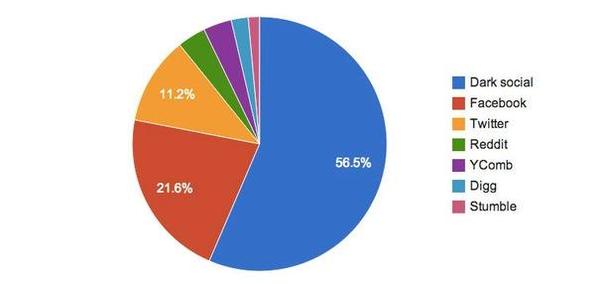Dark Social - the majority of your social traffic is invisible close
In Online Innovation

The web seems to be all about social media these days. Since the introduction of Facebook, Twitter & Co in the mid 2000s we tend to use the term “social networks” as a synonym for the social web. But if you think about it, that’s not the whole truth. There are other channels that make the web social, like email, chat rooms and instant messaging. However, they don’t get the attention that they should because they are considered old, outdated or just not that important. What a fatal assumption! Alexis Madrigal of The Atlantic calls these underestimated social tools Dark Social and found out that they are far more significant than we might think.
Public Linksharing vs Private Linksharing
Think about your own sharing behaviour. Do you share every article you like or want to talk about with someone else on Facebook? Or do you also email or IM directly links to pages of content would be useful for them to specific people? I know I do. I use Email, Skype, WhatsApp and mysms to share links that I consider worth reading, but don’t want to necessarily share with everybody. And that’s the point. Dark social is private. Facebook, Twitter and other social networks make sharing public. That’s publishing really. Publishing links makes them visible and searchable – it forms your online identity.
Also, the tools themselves are underestimated – they are the power of dark social links. In times where we connect with everyone we’ve ever met on social networks, a link from a LinkedIn contact is less valuable to us than a link in a Skype message from a real friend. Trust is a big issue here. We trust people we know and click on links they recommend us personally. It comes as no real surprise that click-through rates are substantially higher in dark social than social networks.
Measuring Dark Social – is that even possible?
Now this is where it gets complicated, because the information web analytics provide us is limited. It does tell us where visitors come from, but maybe not as detailed as we would like to know. We know whether someone came from a search engine, Facebook or Twitter. And then there’s this one metric called direct traffic. Many of us web analytic geeks – actually I think most of us – assume that this number tells us how many visitors typed in the URL directly or have the website saved in their bookmarks. However, it is very, very likely that some of these direct visitors landed on a website, because they clicked a dark social link.
There is one thing you can do to try and measure dark social (but the truth is you won’t be able to quantify all dark social links!). Alexis Madrigal and the guys from Chartbeat made a reasonable attempt to split dark social traffic from direct traffic. They divided visitors into two groups:
Group A (direct traffic) are visitors who entered a website on its homepage (e.g. http://www.codegent.com/) or on a big sub page (e.g. http://www.codegent.com/blog)
Group B (dark social traffic) are visitors who entered a website on a deeper page (e.g. http://www.codegent.com/blog/2013/1/5-things-you-need-to-know-about-retargeting). As hardly anyone types that in, they assumed these people must have clicked on a link to get there.
With their new metric they analysed The Atlantic’s web traffic. The results are astonishing:

Dark social traffic accounts for more than half of the website’s social traffic. Now, who would have thought that before starting to read about the dark social phenomenon? 56.5% is 2.5 x the Facebook traffic to the site! And this is not an individual case. Martin Clarke from MailOnline says
“the sharing of links between friends via email and instant messaging services is more important than search or social to MailOnline’s success.”
The only solution to dark social is…
…relevant content! You can’t game instant messages or emails. You can’t identify opinion leaders and there’s no algorithm for dark social. The only thing you can do to optimise dark social is to put relevant content out there that people actually want to share with their friends.